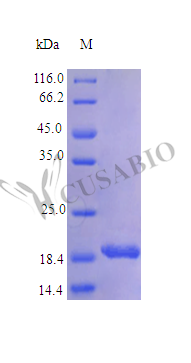The gene fragment encoding the 22-199aa of human IL11 is cloned into a vector and then transfected into the E.coli for expression. The resulting product is the recombinant human IL11 protein. It has been validated to be biologically active by a cell proliferation assay using murine B9-11 cells, with an ED50 of < 1 ng/ml, corresponding to a specific activity of >1.0x106 IU/mg. Its purity is greater than 95% as measured by SDS-PAGE. Its endotoxin level is less than 1.0 EU/μg as determined by the LAL method.
Human IL11 is primarily produced by a variety of cell types, including fibroblasts, macrophages, and endothelial cells, and it exerts its biological effects through the gp130 receptor signaling pathway, which it shares with other cytokines in the same family, such as IL6 and leukemia inhibitory factor (LIF) [1][2].
IL11 is known for its anti-inflammatory properties and its ability to promote the proliferation and differentiation of hematopoietic progenitor cells, particularly megakaryocytes, which are essential for platelet production [3][4]. Beyond hematopoiesis, IL11 is implicated in various pathological conditions, including cancer. Studies have shown that IL11 can enhance the invasive properties of certain cancer cells, such as those found in gastric and colorectal carcinomas, suggesting its involvement in tumor progression and metastasis [5][6]. IL11 can also modulate the activity of immune cells, influencing their proliferation and differentiation, which has implications for autoimmune diseases and inflammatory conditions [7][8].
References:
[1] P. Paiva, L. Salamonsen, U. Manuelpillai, & E. Dimitriadis, Interleukin 11 inhibits human trophoblast invasion indicating a likely role in the decidual restraint of trophoblast invasion during placentation1, Biology of Reproduction, vol. 80, no. 2, p. 302-310, 2009. https://doi.org/10.1095/biolreprod.108.071415
[2] B. Sands, B. Winston, B. Salzberg, M. Safdi, C. Barish, L. Wrubleet al., Randomized, controlled trial of recombinant human interleukin‐11 in patients with active crohn's disease, Alimentary Pharmacology & Therapeutics, vol. 16, no. 3, p. 399-406, 2002. https://doi.org/10.1046/j.1365-2036.2002.01179.x
[3] Y. Xiao, J. Liu, X. Huang, J. Guo, P. Fu, X. Huanget al., A clinical study on juheli (recombinant human interleukin - 11) in the second prevention of chemotherapy induced thrombocytopenia, Asian Pacific Journal of Cancer Prevention, vol. 17, no. 2, p. 485-489, 2016. https://doi.org/10.7314/apjcp.2016.17.2.485
[4] S. Sun, W. Wang, Y. Latchman, D. Gao, B. Aronow, & J. Reems, Expression of plasma membrane receptor genes during megakaryocyte development, Physiological Genomics, vol. 45, no. 6, p. 217-227, 2013. https://doi.org/10.1152/physiolgenomics.00056.2012
[5] T. Nakayama, A. Yoshizaki, S. Izumida, T. Suehiro, S. Maeda, T. Uemuraet al., Expression of interleukin-11 (il-11) and il-11 receptor α in human gastric carcinoma and il-11 upregulates the invasive activity of human gastric carcinoma cells, International Journal of Oncology, 2007. https://doi.org/10.3892/ijo.30.4.825
[6] A. Yoshizaki, T. Nakayama, K. Yamazumi, Y. Yakata, M. Taba, & I. Sekine, Expression of interleukin (il)-11 and il-11 receptor in human colorectal adenocarcinoma: il-11 up-regulation of the invasive and proliferative activity of human colorectal carcinoma cells, International Journal of Oncology, 2006. https://doi.org/10.3892/ijo.29.4.869
[7] H. Elshabrawy, M. Volin, A. Essani, Z. Chen, I. McInnes, K. Raemdoncket al., Il-11 facilitates a novel connection between ra joint fibroblasts and endothelial cells, Angiogenesis, vol. 21, no. 2, p. 215-228, 2018. https://doi.org/10.1007/s10456-017-9589-y
[8] V. Lewis, M. Ozawa, M. Deavers, G. Wang, T. Shintani, W. Arapet al., The interleukin-11 receptor α as a candidate ligand-directed target in osteosarcoma: consistent data from cell lines, orthotopic models, and human tumor samples, Cancer Research, vol. 69, no. 5, p. 1995-1999, 2009. https://doi.org/10.1158/0008-5472.can-08-4845






